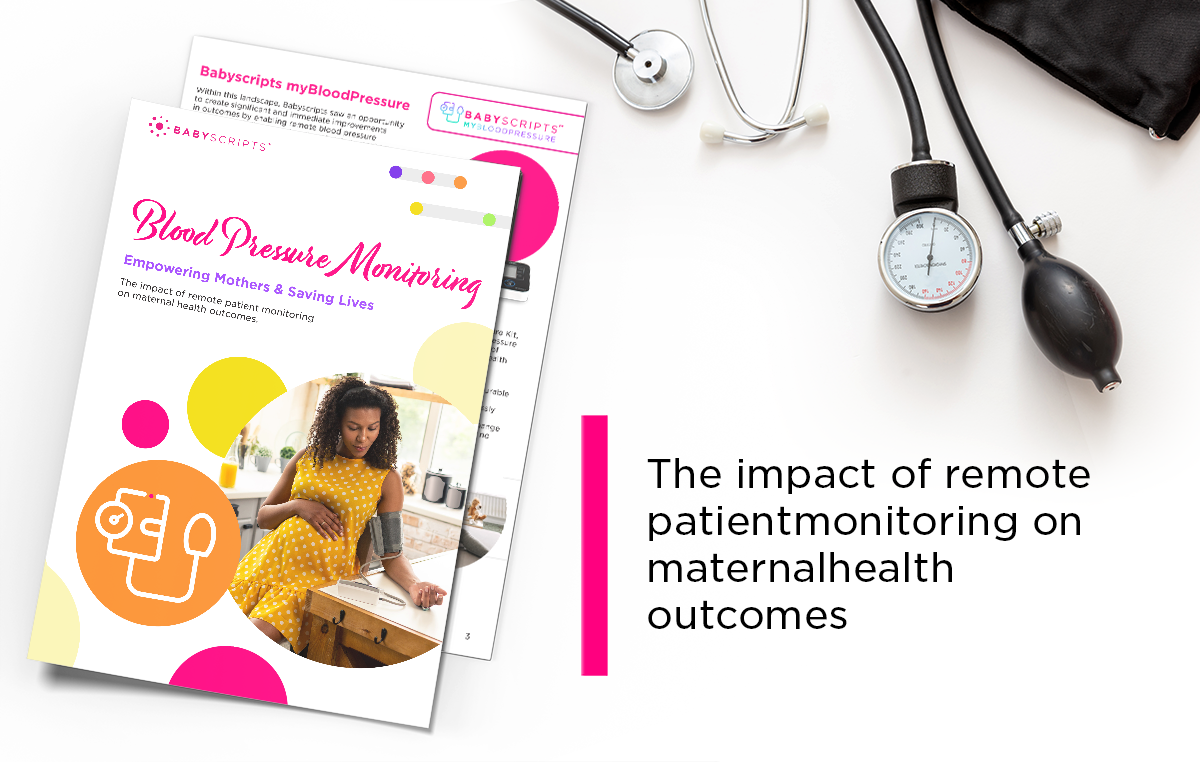
In our years of experience in the maternal health space, Babyscripts has found that blood pressure monitoring is the most effective tool for immediately targeting and improving preventable maternal mortality and morbidity. We’ve leveraged our six years worth of data and on-the-ground experience to deliver cutting-edge tools for blood pressure monitoring and other solutions, and we’re looking forward to announcing our newest innovation soon!
So why blood pressure?
Social determinants of health, structural barriers to care, scarcity of providers, the way that maternity care is delivered in the US — all of these factors play a role in outcomes — but the causes of these challenges are varied and hard to localize, and consequently more difficult to resolve.
- We need to focus on fixing the issues that can help the most people in the shortest time, that don’t require decades of cultural and structural change to resolve. Incentivizing young people to become doctors and midwives may be a solution for the long term, but that’s no help to the women who are dying today. Identifying structural racism and educating caregivers on its effects is a start, but an issue that is deeply embedded in the foundation of our country is not going to be resolved overnight.
- We need to go after actionable targets, starting with preventable prenatal and postpartum deaths and the issues that can contribute to them. Hypertension and its related complications is one such issue. Hypertensive disorders with onset during pregnancy are responsible for 7.8% of all pregnancy-related deaths, and that doesn’t take into consideration cardiovascular issues and other health problems to which hypertensive disorders of pregnancy (which occur in nearly 10% of all gestations) are often a precursor.
- Every pregnant woman should be on blood pressure monitoring, through and up to at least 6 weeks postpartum. Maintaining a certain BP has been proven to directly affect the risk of hypertension and improve outcomes. In some cases, elevated blood pressure is the only indication of a dangerous condition like preeclampsia. If a woman is only having her BP taken at her regularly scheduled prenatal visits, it is highly possible that high blood pressure could go undetected.
During the postpartum period, the safety net is even worse — women typically do not see their doctor until a single follow-up appointment 6 weeks after giving birth. Many women fail to attend this appointment, and for some others, six weeks is already too late to catch life-threatening complications. A new mother who is normotensive at discharge can quickly become hypertensive in the days following childbirth, even if she experienced no blood pressure complications before or during her pregnancy.
Make immediate impact.
If we focus on BP, we can cut death rates overnight by giving patients more tools today; and incidentally, dramatically reduce the costs to health systems resulting from preeclampsia, preterm birth (directly correlated to preeclampsia), readmissions, and other costly complications related to hypertension.
Extend provider reach.
Remote BP monitoring can also begin to solve some of the larger structural issues at play in maternal healthcare. The use of remote tools can extend the reach of overburdened physicians and provide access to care for women living in maternity care deserts. It can also address racial inequities in the system. A recent study confirms that black women are at higher risk for persistent hypertension after delivery, and identifies remote BP monitoring as a potential means to target and aggressively treat pregnancy-related hypertension in black women after delivery.
Empower women.
The benefits of monitoring BP during pregnancy have staying power. With good habits around BP developed during pregnancy, women are more likely to continue to watch and learn about their BP trends throughout their lives. Pregnancy is often a woman’s first encounter with the healthcare system, and therefore an ideal time to solidify good habits and behaviors.
With the experience of remote monitoring of BP in pregnancy, women can go on to advocate for themselves for treatment of elevated BPs and prevention of chronic disease resulting from hypertension. The more that patient and provider are both actively involved in management of BP, the more successful it will be.
So what’s holding us back from wide scale adoption of remote blood pressure monitoring?
Providing a BP cuff to every single pregnant person would cost upwards of $200M — a steep price, yes. But compared to nearly $3B dollars in cost associated with preeclampsia? The $13B+ for preterm birth (a result of 15% of preeclamptic pregnancies)? The $500M in readmission costs for postpartum hypertension? And those costs don’t take into account the massive downstream societal costs of maternal death and morbidity.
Investments in Infrastructure.
Of course the provision of a blood pressure cuff is only part of the solution. As a vehicle for data collection, a cuff is essential. But data is only as effective as the infrastructure that makes it actionable. We need to invest in infrastructure that communicates that data back to stakeholders (in this case, clinicians) in actionable ways — infrastructure that supports diagnostic data, integrates clinical protocols, functions within existing workflows and communicates across different data platforms.
This infrastructure already exists, and has only become more sophisticated with the advent of the Internet of Things, but healthcare industry standards are stuck in the past, and they need to adapt to incorporate and support it.
Payer Involvement.
Payers can play a major role in encouraging these industry shifts — several years ago, Medicare unbundled remote patient monitoring (RPM) reimbursement and is now fully supporting the use of digital tools to provide access to care for its patient population.
So why are commercial payers and Medicaid lagging behind? The pandemic has accelerated the inevitable shift to a more virtual model of care, and payers are in a position to cement that shift and affect immediate improvements on the system. There needs to be widespread adoption of CPT codes, or new codes specifically designed for maternal health monitoring.
Updated Maternal Health Legislation.
Congress has been proactive in proposing initiatives for improving maternal health, but the question of reimbursement is a major hurdle that they have yet to address. Any legislation directed to improvements in maternal health needs to include bottom-line incentives for providers — and incorporating the payer is a way to do that effectively.
Babyscripts involves the payer through our Joint Deployment model; and we’ve also been active in advocating for maternal health legislation, creating creative pathways for reimbursement, and seeking out the partners and accelerators that can help us continue to provide the best tools to address maternal health. Stay tuned for upcoming developments from our product team!


Comments (3)